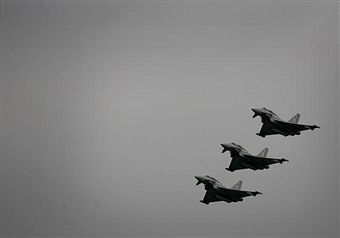 Liam Fox is anticipating the Strategic Defence Review, preparing the services for what
will be extremely bad news. Britain will not engage in large scale operations in the immediate future. The Telegraph reports that officials intend to reduce the number of strike aircraft,
warships and tanks. Future strategic emphasis will be on maximising firepower and range and minimising direct and associated costs.
Liam Fox is anticipating the Strategic Defence Review, preparing the services for what
will be extremely bad news. Britain will not engage in large scale operations in the immediate future. The Telegraph reports that officials intend to reduce the number of strike aircraft,
warships and tanks. Future strategic emphasis will be on maximising firepower and range and minimising direct and associated costs.
The service arms have mobilised their writers to prepare a defence. The Times have hosted a set-to between Air-Vice Marshall Tony Mason and Major General Julian Thompson. Mason’s argument is
simple: warfare is determined by air superiority. He writes:
‘Since Dunkirk, British Armed Forces have usually fought beneath skies controlled by friendly aircraft. When they did not, in the Falklands conflict, surface forces suffered grievous losses. “Command of the air” is indispensable, and has, for good reason, been recognised as the primary role of the RAF from its birth. The RAF is often exposed to ill-informed criticism of the costs of its aircraft and systems. This overlooks its real operational cost-effectiveness: its versatility as a multiplier of the power of other forces on land and sea. The shape and size of the RAF should be determined by its capacity to contribute at all levels from counter-insurgency to high-intensity conflict. It will need to control the skies, attack, provide intelligence and supply airlift over distances and at speeds unattainable by surface forces. The Eurofighter Typhoon was conceived in the Cold War, but in its modern form it guarantees the integrity of British airspace. Overseas, in Afghanistan and elsewhere, it will enable freedom of movement for ground forces, while denying similar activities to the opposition. The costs of the Typhoon are visible, but those who call for its demise are woefully ignorant of military history and the fate of soldiers and sailors exposed to enemy air attack. Future opponents won’t allow airspace to go uncontested.’
That is all true, but you do not need squadrons of expensive strike aircraft to master the uncontested skies of Afghanistan, or Somalia or The Yemen. And you certainly do not need an independent command structure to operate that arm, given that Britain’s strategic needs have changed since WW2 and the Cold War. That, essentially, is Thompson’s conclusion. He writes:
‘The nuclear deterrent is a vital part of our defence against a direct attack; it should remain and be replaced eventually. We will still need high-quality special forces. We need a strong and capable Navy to protect our vital interests, including the 98 per cent of the commodities carried on ships that we need for our prosperity and indeed our survival. We require carriers, to avoid being forced to base our aircraft in someone else’s country. Therefore the aircraft carriers should be built. Because 80 per cent of the cities in the world and 70 per cent of the population are situated less than 100 miles from the sea, our Navy needs an amphibious capability. To quote General Sir David Richards, the next Chief of the Defence Staff: “You need green and brown water fleets … that allow you to reach into ungoverned space and make your presence felt.” The necessary shipping is already built and paid for and will last beyond 2030. We need a light, deployable Army, with a strong Territorial element capable of home defence. The Army should be structured for deployment in joint operations with the Navy to deal with specific and defined terrorist threats from abroad, and threats to dependencies. Tanks and heavy artillery should be phased out. The RAF should be abolished, and its aircraft divided between the Navy and Army. All maritime assets would go to the Navy, including maritime patrol aircraft, search-and-rescue and helicopters for amphibious operations. The Navy would take over responsibility for the air defence of the UK, employing the Joint Strike Fighter. The Army would take over all troop lift helicopters except those in the amphibious force, and all transport aircraft. Dispensing with the top structure of the RAF would make substantial savings.’
Fox recognises that substantial cuts in hardware are undesirable, especially as most of the money has already been spent on future orders. Procurement and command structure are more obvious targets for cuts to deliver cheap armed forces in the long-term.






Comments